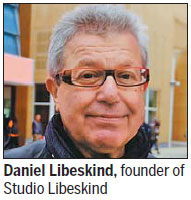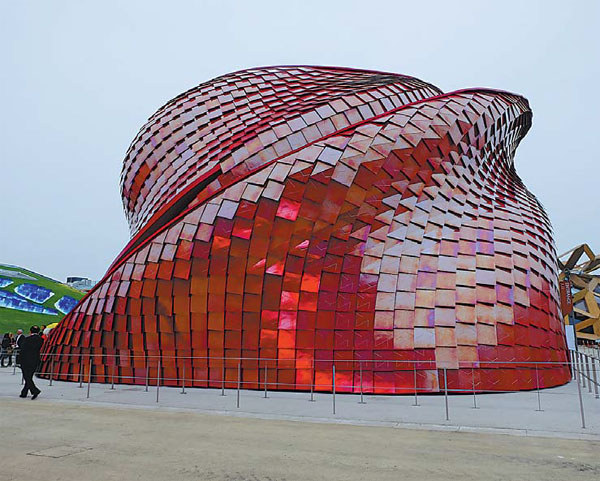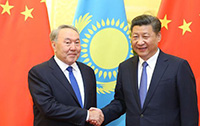Red dragon and green values soar over Milan show
By Cecily Liu (China Daily Europe) Updated: 2015-05-08 07:37A lover of Chinese art pours his heart into expo pavilion
The Chinese developer Vanke has unveiled its first building outside China, in the form of a pavilion at the Milan Expo, showing to the world the innovation and green building philosophy at the heart of the company's culture.
The pavilion's exterior is made from red square tiles, resembling the body of a dragon that is central to Chinese culture. The tiles are environmentally friendly and recyclable, consistent with the high value Vanke places in green building.
|
The construction of the 1,000-square-meter pavilion for Chinese developer Vanke was among the first at the Milan Expo to be completed on time and on budget. [Photo by Cecily Liu / China Daily] |
The interior of the pavilion includes space where visitors can eat while chatting. It is named the shitang, a traditional dining hall.
The construction of the 1,000-square-meter pavilion was among the first at the Milan Expo to be completed on time and on budget. Vanke has invested about 30 million euros in the expo.
Daniel Libeskind, founder of Studio Libeskind, who designed the exterior of the pavilion, says that the pavilion is a great ambassador for green building technology and for the image of Vanke on the global platform.
Libeskind says he has always been fascinated by Chinese culture, Chinese philosophy and Chinese art, from which he drew inspiration for the design. He is particularly fascinated by 14th and 15th century Chinese landscape paintings, which he sees as being alive and possessing a soul.
"I was fascinated by the mountains, the landscape, the birds and mythological figures. I've seen those paintings in China and also in New York. I found the landscape to be amazing forms, portrayed as a living being."
He says that initially he did not have in mind the dragon design, but instead drew inspiration from Chinese landscapes, stories and literature, combining his understanding of Chinese culture from all those sources into the overall design, which his Chinese friends later told him resembled a dragon.
"So I was happy when people found it to be a dragon, and I think that may be because the dragon is so connected with the Chinese culture in many ways."
The pavilion is clad in more than 4,000 red metalized tiles that Libeskind designed with the Italian company Casalgrande Padana. The geometric ceramic panels possess highly self-cleaning and air purification properties, and the surface of the tiles change color from red to gold as one's perspective changes.
Libeskind says these tiles represent a new green building technology that is energy efficient in the production and construction process, and can be recycled. In fact, the whole pavilion will be recycled after the expo, in line with the expo's theme of sustainability.
"It is very cost effective technology, and it's not just something we'd throw away once we have finished using it. Hence it is important to be shown at the expo, because the expo is for new ideas, not things we've shown before."

Libeskind is using this pioneering technology in a project in Berlin, but he says he hopes to work with Vanke on more green building technology because Vanke's importance in the Chinese market and its green ideology provide great opportunities.
In recent years Vanke has shifted its focus from being purely a property developer to becoming a national leader in green-building technologies. Although Vanke has only built 3 percent of China's total residential properties, it has built about 30 percent of the country's green buildings.
Vanke was founded in 1984 and has become China's largest residential real estate developer, with about 200 billion yuan ($32 billion; 28 billion euros) in sales last year.
One feature of the exterior of the pavilion is its fluid and rounded shape, with no backdoor or observable spaces dedicated to support functions, meaning the whole space is used for the benefit of visitors.
"It's a living space, it creates a brilliant atmosphere and the space is used effectively to maximize its value to visitors," Libeskind says.
"It is also a beautiful living space, and I think as more and more people move from rural to urban China, they will need a beautiful space to live in, rather than just any space. I see architecture in China in the future as being big and beautiful."
Libeskind first met the Vanke team at the Shanghai Expo in 2010, when he visited the Vanke pavilion. "I was very impressed with the pavilion, and I think it's a great company with a great vision and progressive ideas. I liked their ideas very much," he says.
Since then he has worked with Vanke on delivering the Vanke Pavilion in Milan and says he enjoyed it.
"They are very collaborative, willing to share their culture, and they have a sense of commitment to China, and commitment to the wider world that we are a part of. I've enjoyed working with their creative team."
Libeskind says the Vanke Pavilion demonstrates a great combination between Chinese culture and tradition and modern technology, to make people's lives more beautiful and harmonious.
"It is a living representation of China. It really lives, really breathes and really changes."
As an aficionado of Chinese culture, Libeskind says he looks forward to its gradual globalization.
"I find Chinese culture unique because it is yet to be discovered. We call it culture, but it's a whole civilization that gave birth to many things, like Chinese mathematics, Chinese astronomy, Chinese philosophy, Chinese medicine, and the Chinese way of living."
He says China's ideas about the world are very progressive, and in previous decades perhaps they were not well known to the world because for many years the world has not understood China.
"For example, when people talk about China in relation to Africa they don't understand that China is one of the first countries to help Africa to trade in a sustainable way. The Chinese way of thinking has a lot of impact on contemporary thinking globally."
The interior of the pavilion, is just as impressive as the exterior, with an exhibition area by the designer Ralph Appelbaum that resembles a traditional Chinese dining hall.
It is filled with a constellation of 200 screens mounted to a matrix of bamboo scaffolding, and the forest of screens and bamboo floats border the visitor pathway. As visitors move through the space, a 10-minute narrative experience unfolds across the screens and through 22 audio channels.
The narrative moves between chaos and calm, resembling the frenzy of life in the city: the pulsing of traffic and the swell of crowds.
Wang Shi, chairman of Vanke, says the design of the food hall reflects Chinese culture, because China is experiencing rapid urbanization and as people move from the country to the city their first experience of the new life is a need to eat food in dining halls with many other people.
In this sense, Vanke wanted to showcase an element of Chinese food culture so crucial and close to the lives of ordinary people, but is at the same time consistent with the Milan Expo's overall theme of food and sustainability.





